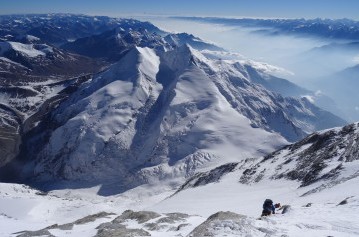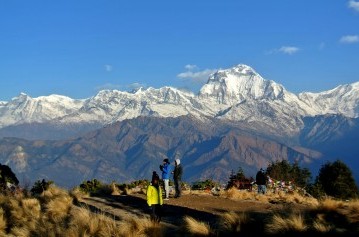
Dhaulagiri Region: "Adventure Awaits in the Land of the White Mountain"
The Dhaulagiri Region is a haven for adventurous trekkers and mountaineers, offering some of the most challenging and rewarding experiences in Nepal. Dominated by the towering Dhaulagiri massif, the seventh highest mountain in the world at 8,167 meters, this region is renowned for its dramatic landscapes, remote villages, and pristine natural beauty.
The Dhaulagiri Region lies in the western part of Nepal, separated from the Annapurna Range by the deep Kali Gandaki Gorge, the world's deepest gorge. This area is characterized by its rugged terrain, towering peaks, and a sense of solitude that appeals to those seeking a true wilderness adventure. The Dhaulagiri Circuit Trek, in particular, is a highlight for trekkers, offering a challenging and unforgettable journey through this remote and awe-inspiring landscape.
Why Trek in the Dhaulagiri Region?
Trekking in the Dhaulagiri Region offers a unique and thrilling adventure for those seeking to explore one of Nepal's most remote and spectacular areas. Here are some compelling reasons to choose the Dhaulagiri Region for your next trekking expedition:
1. Majestic Mountain Views
- Dhaulagiri Massif: Witness the grandeur of Dhaulagiri, the seventh highest mountain in the world at 8,167 meters. Its towering presence and solitary magnificence make it a sight to behold.
- Panoramic Peaks: Enjoy panoramic views of other towering peaks, including the Annapurna range, providing a breathtaking backdrop throughout your trek.
2. Challenging and Rewarding Trails
- Adventure: The Dhaulagiri Circuit Trek is renowned for its challenging trails, making it perfect for experienced trekkers looking for a demanding and rewarding journey.
- High Passes: Conquer high mountain passes like French Pass (5,360 meters) and Dhampus Pass (5,250 meters), offering exhilarating experiences and stunning vistas.
3. Pristine Natural Beauty
- Diverse Landscapes: Trek through a variety of landscapes, from lush subtropical forests and terraced fields to high alpine meadows and glaciated terrains.
- Hidden Valley: Explore the remote and pristine Hidden Valley, a secluded area that offers tranquility and untouched natural beauty.
4. Cultural Encounters
- Traditional Villages: Pass through remote villages inhabited by the Magar and Thakali people, offering a glimpse into traditional Himalayan life and culture.
- Warm Hospitality: Experience the warm-hearted hospitality of the local communities, who share their unique culture and traditions with trekkers.
5. Solitude and Tranquility
- Off the Beaten Path: The Dhaulagiri Region is one of the less-traveled trekking areas in Nepal, providing a sense of solitude and escape from the crowded trails of more popular routes.
- Untouched Wilderness: Immerse yourself in the pristine wilderness, far from the hustle and bustle of modern life, and reconnect with nature in its purest form.
6. Breathtaking Natural Features
- Rhododendron Forests: Trek through lush rhododendron forests that burst into bloom in the spring, adding vibrant colors to the landscape.
- Glacial Landscapes: Marvel at the stunning glaciated terrains and the dramatic contrasts of ice and rock, creating a surreal trekking environment.
7. Personal Achievement
- Physical Challenge: The demanding nature of the trek provides a significant physical challenge, rewarding trekkers with a sense of accomplishment and personal achievement.
- Unique Experience: Completing the Dhaulagiri Circuit Trek is a unique and memorable experience that few trekkers undertake, adding to the sense of adventure and exploration.
8. Myagdi and Magar Villages
The trek passes through various villages inhabited by the Magar and Thakali people. These communities offer a glimpse into traditional mountain life, with their unique cultures, traditions, and warm hospitality.
Essential Information for trekking in Dhaulagiri Region
Best Time: The best times to trek in the Dhaulagiri Region are from late March to May and from September to early November. During these periods, the weather is generally stable, and the views of the mountains are clear.
Trekking Permits: Trekkers need several permits to trek in the Dhaulagiri Region, including the Annapurna Conservation Area Permit (ACAP) and a TIMS (Trekkers' Information Management System) card. For those venturing into restricted areas, additional permits may be required.
Accommodation: Accommodation in the Dhaulagiri Region ranges from basic teahouses to camping in more remote areas. Trekkers should be prepared for rustic conditions, especially at higher altitudes.
Packing List
Essential items to pack include:
- Sturdy trekking boots
- Warm clothing and layers
- A reliable map and compass
- Personal medication and a first aid kit
- A good quality sleeping bag
- Trekking poles
- Sunscreen and sunglasses
The Dhaulagiri Region offers a unique and challenging trekking experience for those seeking to explore one of Nepal's most remote and stunning areas. Whether trekking the Dhaulagiri Circuit, crossing high passes, or discovering hidden valleys, this region promises an adventure of a lifetime. Embrace the solitude, marvel at the breathtaking landscapes, and immerse yourself in the rich culture of the local communities in the land of the White Mountain.
Experience the Dhaulagiri Region Trek with Asian Adventure Treks & Expedition - Professional Planner for your vacations!
Featured trips for Dhaulagiri Region
Easy trekking are basically for the beginners. This kind of treks is typically done in the lower hilly region of elevation below 3500 metre. The trails in this trek are generally vertical and walking time is 3 - 5 hours everyday.
Moderate types of trekking generally take place on the low altitude zone crossing the passes below the elevation of 4500 meters. Normally the walking is from 4 - 6 hours each day.
Hard kind of trekking routes crosses through the wild and adventurous trails and sometimes passes through the snow covered high passes between 4500 meters to 5500 meters. Usually the walks takes from 7-8 hours everyday.
Generally this types of routes are demanding long distance treks where the walks takes up to 9 hours each day. Each trail crosses at least one pass over 5500 meters frequently contains hardly ever explored regions. Challenging are the expedition types of activity.

